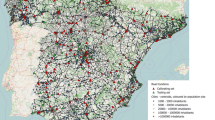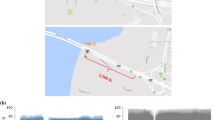Abstract
As in other panel data analyses, the presence of unobserved heterogeneity is a critical issue in the estimation of infrastructure performance models. In the literature, this issue has been addressed by formulating variable intercept, fixed or random effects models under the assumptions that (1) heterogeneity stems from facility/individual-level effects, and that (2) the coefficients are constant and homogeneous across the population. In contrast, we present mixture regression as a performance modeling framework. The approach relies on the assumption that the underlying population is comprised of a finite set of classes/segments in unknown proportions. The segmentation basis is latent meaning that the criteria to establish the number and type of segments are related to unobserved heterogeneity manifested in facility performance/deterioration. The segments are characterized by a set of commonly specified regression equations, which allows for the identification and estimation of coefficients, i.e., group-level effects, that differ in terms of their level-of-significance, magnitude or sign. We also derive an instance of the Expectation-Maximization Algorithm to estimate the associated parameters, and to assign facilities to the population segments. To illustrate the framework, we analyze the performance of a panel of 131 pavements from the AASHO Road Test. The results suggest both observed and unobserved sources of heterogeneity in the panel. The heterogeneity is captured by differential group-level effects, which we estimate and interpret. We also discuss how these effects can be exploited in the development of resource allocation strategies. We also compare the mixture regression model to established benchmarks.




Similar content being viewed by others
References
Archilla A (2006) Repeated measurement data analysis in pavement deterioration modeling. J Infrastruct Syst 12(3):163–173
Archilla A, Madanat S (2000) Development of a pavement rutting model from experimental data. J Transp Eng 126(4):291–299
Ben-Akiva M, Humplick F, Madanat S, Ramaswamy R (1993) Infrastructure management under uncertainty: The latent performance approach. ASCE J Transp Eng 119(1):43–58
Carnahan J, Davis W, Shahin M, Keane P, Wu M (1987) Optimal maintenance decisions for pavement management. ASCE J Transp Eng 113(5):554–573
Chu C, Durango-Cohen P (2008a) Empirical comparison of statistical pavement performance models. J Infrastruct Syst 14(2):138–149
Chu C, Durango-Cohen P (2008b) Estimation of dynamic performance models for transportation infrastructure using panel data. Transp Res Part B Methodol 42(1):57–81
Chu C, Durango-Cohen P (2008c) Incorporating maintenance effectiveness in the estimation of dynamic infrastructure performance models. Comput Aided Civ Infrastruct Eng 23(3):174–188
Daziano RA, Bolduc D (2013) Incorporating pro-environmental preferences towards green automobile technologies through a bayesian hybrid choice model. Transp A Transp Sci 9(1):74–106
Dempster A, Laird N, Rubin D (1977) Maximum likelihood from incomplete data via the em algorithm. J R Stat Soc Ser B 39(1):1–38
Gaffney S, Smyth P (1999) Trajectory clustering with mixtures of regression models. In: Proceedings of the fifth ACM SIGKDD international conference on Knowledge discovery and data mining, ACM, pp 63–72
Gendreau M, Soriano P (1998) Airport pavement management systems: an appraisal of existing methodologies. Transp Res Part A 32(3):197–214
Golabi K, Kulkarni R, Way G (1982) A statewide pavement management system. Interfaces 12(6):5–21
Goldberger AS (1962) Best linear unbiased prediction in the generalized linear regression model. J Am Stat Assoc 57(298):369–375
Greene W (2011) Econometric Analysis, 7th edn. Prentice Hall, Upper Saddle River, NJ
Highway Research Board (1962) The AASHO Road Test, Special Report No. 61A-E. National Academy of Science, National Research Council, Washington, DC.
Hong F, Prozzi J (2006) Estimation of pavement performance deterioration using bayesian approach. J Infrastruct Syst 12(2):77–86
Hong F, Prozzi J (2010) Roughness model accounting for heterogeneity based on in-service pavement performance data. J Transp Eng 136(3):205–213
Hsiao C (1986) Analysis of panel data. Cambridge University Press, Cambridge, UK
Hudson W, Haas R, Uddin W (1997) Infrastructure management. McGraw-Hill, New York, NY
Humplick F (1992) Highway pavement distress evaluation: modeling measurement error. Transp Res Part B Methodol 26(2):135–154
Jedidi K, Jagpal HS, DeSarbo WS (1997) Finite-mixture structural equation models for response-based segmentation and unobserved heterogeneity. Mark Sci 16(1):39–59
Luo Z, Chou Y (2006) Pavement condition prediction using clusterwise regression. Transp Res Rec 1974:70–77
Luo Z, Yin H (2008) Probabilistic analysis of pavement distress ratings with the clusterwise regression method. Transp Res Rec 2084:38–46
Madanat S, Karlaftis M, McCarthy P (1997) Probabilistic infrastructure deterioration models with panel data. J Infrastruct Syst 3(1):4–9
Malyshkina NV, Mannering FL (2009) Markov switching multinomial logit model: an application to accident-injury severities. Accid Anal Prev 41(4):829–838
Malyshkina NV, Mannering FL, Tarko AP (2009) Markov switching negative binomial models: an application to vehicle accident frequencies. Accid Anal Prev 41(2):217–226
McGilchrista C, Yaua K (1995) The derivation of blup, ml, reml estimation methods for generalised linear mixed models. Commun Stat Theory Methods 24(12):2963–2980
McNeil S, Markow M, Neumann L, Ordway J, Uzarski D (1992) Emerging issues in transportation facilities management. J Transp Eng 118(4):477–495
Onar A, Thomas F, B C, Byron T (2006) Statistical mixed effects models for evaluation and prediction of accelerated pavement testing results. J Transp Eng 132(10):771–780
Park BJ, Lord D (2009) Application of finite mixture models for vehicle crash data analysis. Accid Anal Prev 41(4):683–691
Prozzi J, Madanat S (2003) Incremental nonlinear model for predicting pavement serviceability. J Transp Eng 129(6):635–641
Späth H (1977) Computational experience with the exchange method. Eur J Oper Res 1(1):23–31
Späth H (1979) Algorithm 39: Clusterwise linear regression. Computing 22:367–373
Späth H (1982) Algorithm 48: A fast algorithm for clusterwise linear regression. Computing 29:175–181
Van Noortwjk J, Frangopol D (2004) Deterioration and maintenance models for insuring safety of civil infrastructures at lowest life-cycle cost. In: Faber M, Adey B (eds) Frangopol D, Br\(\ddot{\text{ u }}\)hwiler E. Published in Life-Cycle Performance of Deteriorating Structures, Assessment, Design and Management, ASCE, pp 384–391
Vij A, Carrel A, Walker JL (2013) Incorporating the influence of latent modal preferences on travel mode choice behavior. Transp Res Part A Polic Pract 54:164–178
Washington S, Karlaftis M, Mannering F (2011) Statistical and econometric methods for transportation data analysis, 2nd edn. Chapman & Hall/CRC, Boca Raton, FL
Wedel M, Kamakura W (2000) Market segmentation: conceptual and methodological foundations. Kluwer Academic Publishers, Norwell, MA
Xiong Y, Mannering FL (2013) The heterogeneous effects of guardian supervision on adolescent driver-injury severities: A finite-mixture random-parameters approach. Transp Res Part B Methodol 49:39–54
Xu L, Jordan MI, Hinton GE (1995) An alternative model for mixtures of experts. Advances in neural information processing systems pp 633–640
Yu J, Chou E, Luo Z (2007) Development of linear mixed effects models for predicting individual pavement conditions. J Transp Eng 133(6):347–354
Zhang W, Durango-Cohen P (2014) Explaining heterogeneity in pavement deterioration: a clusterwise linear regression model. J Infrastruct Syst 20(2):04014005 1–9
Acknowledgments
This research was partially supported by a Dissertation Year Fellowship awarded by The Northwestern University Transportation Center to the second author.
Author information
Authors and Affiliations
Corresponding author
Rights and permissions
About this article
Cite this article
Medury, A., Zhang, W. & Durango-Cohen, P.L. Identification and estimation of latent group-level-effects in infrastructure performance modeling. EURO J Transp Logist 4, 31–55 (2015). https://doi.org/10.1007/s13676-014-0057-1
Received:
Accepted:
Published:
Issue Date:
DOI: https://doi.org/10.1007/s13676-014-0057-1




